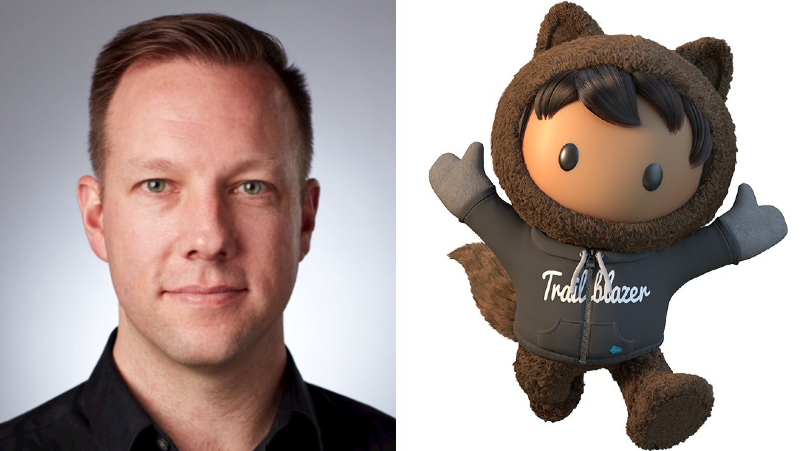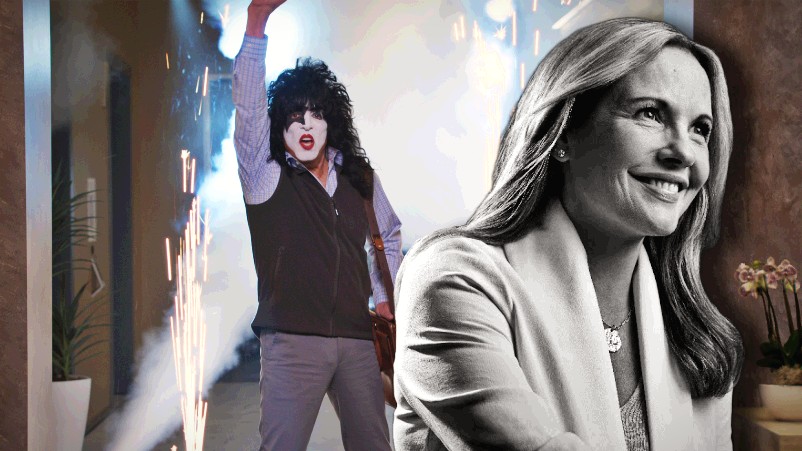Vanity metrics must die: Salesforce's top marketer culls content, meaningless reporting as growing pains bite
An Mi3 editorial series brought to you by
LinkedIn


An Mi3 editorial series brought to you by
LinkedIn

Salesforce’s brand chief is waging war on vanity metrics – i.e. measuring quantity of output over quality of result. Hence the firm is no longer worrying about the number of blog posts produced or open rates, instead focusing for actual outcomes: “It’s all about moving things down the funnel”, per Chief Brand Officer, Colin Fleming. For better or worse, he’s acting like a publisher: “We’ll cut the pilot because it didn’t work”. Meanwhile, brand personification is paying off big time. But the firm is still working to close the gap between brand awareness and people actually knowing what Salesforce does.
What you need to know:
- Salesforce EVP Global Brand Marketing Colin Fleming is culling vanity metrics – volume-based reporting on marketing activities like the number of blog-posts published.
- He's a disciple of the 95-5 rule, investing in building mental availability within the vast bulk of the market not yet ready to buy – because they are future cashflow. The five per cent that are buying are pretty easy to target.
- He told Cannes that large organisations’ brands are arguably more valuable than their IP.
- Meanwhile brand mascot Astro was originally designed to be a tee-shirt for a developer conference. Now its helping to drive astronomical brand growth.
- But the firm is still working to close the gap between brand awareness and people actually knowing what Salesforce does.
Vanity metrics is a rampant disease inside organisations, for sure. It's something we're working aggressively to eradicate.
Salesforce’s brand chief is waging war on vanity metrics – i.e. measuring quantity of output over quality of result. Hence the firm no longer worrying about the number of blog posts produced or open rates, and instead focusing for actual outcomes: “It’s all about moving things down the funnel”, per Fleming. For better or worse, he’s acting like a publisher: “We’ll cut the pilot because it didn’t work”.
Salesforce expanded massively during Covid. That growth created friction, with some marketers trying to win friends and influence people via vanity metrics. Fleming is not a fan. Now he's wielding the knife to quantity over quality when it comes to things like content volumes, or any quantitative approach.
“That is hard because a lot of people’s worth inside the company is connected to the work that they do. But we have to gravitate to a different altitude – is it working for the company and putting the company first?” said Fleming. “Ultimately, if that content is not good, it is not a valuable exercise.”
He's taking no prisoners when it comes to so-called volume-based or vanity metrics.
“Vanity metrics are a rampant disease inside organisations, for sure. It's something we're working aggressively to eradicate from Salesforce; I think it's important you disassociate people's value inside the organisation with behaviour activity instead of outcomes,” said Fleming.
“As we grew Salesforce so rapidly – we doubled the size of the company during the pandemic – it became activity-based and basically we were attributing things except for the downstream performance. That's a bad thing and it's something we're really aggressively working through.”
I took over the creative team about five years ago, and we've grown it into a brand marketing function. It's based on this simple premise that we need to be thinking about lasting memories with individuals, less so about those individuals ready to buy.
Prior to Salesforce, Fleming was a champion racing driver. Not your average route to the top of the B2B marketing tree, but he thinks the experience – personally raising millions of dollars in sponsorship funds from brands in afforded first hand insight into what makes marketers tick.
“In any professional sport, you are your own individual brand,” Fleming told Cannes. “You have to market your brand and tell your story. You have to curate it. You have to raise money in racing's environment. A lot of it was just learning what CMOs really cared about. I was pitching to CMOs from the age of 15 for sponsorship, and so I learned a lot about what really matters along the way.”
Since then, he’s learned enough to help propel Salesforce into the top 40 most valuable global brands. Fleming goes so far as to suggest the brand “is more valuable than the company's intellectual property in many ways” for large firms.
Which makes investing in brand a CFO priority – doubly so if you apply the 95-5 rule, Fleming suggested. The 95-5 rule, developed by Ehrenberg-Bass Professor John Dawes and The B2B Institute, is that only circa 5 per cent of B2B customers are in market to buy at any one time. The remaining 95 per cent are out of market. So to grow, brands have to target the 95 per cent that are not yet ready to buy.
The rule suggests businesses pursuing high ratios of performance advertising at the expense of brand – i.e. only ever aiming for the 5 per cent – are almost certainly undermining future business earnings performance and future cashflows. Probably not a strategy any finance director would knowingly sanction nor shareholders welcome.
Fleming is also a subscriber to The B2B Institute’s theory of ‘performance branding’, which unlike performance marketing, does not aim to generate a lead, but generate a memory generation. “Simply put, the brand that is remembered is the brand that’s bought with performance branding,” as The B2B Institute’s Peter Weinberg framed it when interviewing Fleming at the Cannes festival.
“[The 95-5 rule] is something that I have personally championed inside Salesforce for about five years,” said Fleming. “I took over the creative team about five years ago, and we've grown it into a brand marketing function. It's based on this simple premise that we need to be thinking about lasting memories with individuals, less so about those individuals ready to buy. We're pretty good at getting those folks in the funnel. It's more about the last thing than 95 per cent that are not thinking [about buying now].”
That’s a long build, given Salesforce's average deal cycle is around 411 days, he added.
Fleming attributes Salesforce's brand success in recent years to two primary aspects: its Astro mascot, and the company’s recognition that even though people know Salesforce exists, most didn’t know what it actually does, which he dubs “the relevance gap”.
Salesforce has roughly 92 per cent aided awareness. People know of Salesforce – and we were thrilled with that. But if you take that same cohort and ask them what we do, it’s closer to 20 per cent. That was a huge problem and is still a problem today to some degree.
Astronomical growth
Astro as a brand mascot was not something that intentionally came out of the marketing department, but was originally drawn for a tee-shirt at a developer event in 2014. “Then it went viral”, said Fleming.
“That's one of my favourite stories about it. Really it came from the community and their evangelism … I think that's a big part of it. We're all in the business of building tribes and we have an incredibly strong and very vocal community – and they were telling us they wanted something different from the company,” added Fleming. “It really forced us to kind of rethink our model and really look back to our disruptive routes.”
Prior to 2015, Salesforce looked “nothing like” it does now. “You could put a Microsoft logo on it. You could put any logo you want on it.” Amid a “sea of sameness”, said Fleming, “that is our litmus test – how do we standout?”
He thinks Astro and the band of Salesforce mascots subsequently spawned are delivering massive gains because they are coupled with a long-term view on brand building over performance and a laser focus on generating memories.
“We've not found an attribution model that allows us to tie all of this revenue growth back to Astro. We do have a pretty strong belief that Astro has helped bring some of that differentiation and that unique attributes back to the Salesforce brand,” said Fleming.
Either way, it appears to be paying off.
“We’ve achieved over 300 per cent growth in brand valuation in the last four years; we've become a top 40 brand; we’ve seen our unaided awareness grow by 26 per cent – and pipe and revenue are following nicely along with it,” said Fleming. “So it shows the role of performance branding, that it can have multiple attributes, multiple effects along the way.”
The relevance gap
Fleming said the “most important slide I’ve ever built in my career” was around what he terms “the relevance gap”.
It followed the firm’s first ever brand equity study.
“We plotted all the charts are realised one important thing: Salesforce has roughly 92 per cent aided awareness. People know of Salesforce – and we were thrilled with that, it took a lot of work to get to that point,” said Fleming.
“But if you take that same cohort and ask them what we do, it’s closer to 20 per cent. That was a huge problem and is still a problem today to some degree.”
So the marketing team built a slide called “the relevance gap” looking at the correlation between knowing the brand, but not knowing what it does.
“There's really an opportunity to speak with the CFO, to operationalise how we think about having to invest in the brand to grow relevant awareness,” said Fleming.
“’Relevant awareness’ has been my rallying cry – the most frequently used word in my vocabulary for five years now to really just articulate the vision for our team, the mission for the marketing organisation to really help close that gap – because brand endures,” he added.
“When you're a company the size of Salesforce or any large organisation, the brand is more valuable than the company's intellectual property in many ways. I think that's a fascinating transition – you have to think about investing in the brand and when you position it like that becomes a pretty obvious statement,” said Fleming.
“But for those of us early in careers or early in smaller organisations, it becomes hard to see that investing in the future, investing in the long-term in the CFO's language. Think about free cashflow, think about long-term and air cover for demand-gen marketing. These are so many attributes here, pricing power, [economic] moats, things like that and it really starts from a kernel of truth – and data is really the driving force behind that at Salesforce.”






